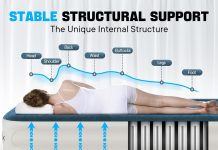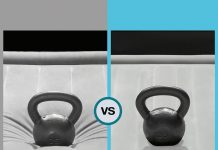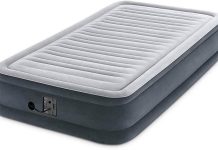Are you waking up in the middle of the night, feeling like you’re sleeping on a deflated balloon? Well, it might be time to consider replacing your air mattress. In this article, we will explore the telltale signs that indicate it’s time to part ways with your trusty inflatable companion. From sagging and loss of firmness to leaks and visible wear and tear, we’ve got you covered. So, if you’re unsure whether your air mattress is on its last leg or just needs a little TLC, read on to discover the signs that it’s time for an upgrade.
Review contents
Signs of Deflation
Slow Deflation
One of the telltale signs that your air mattress may need replacing is when it starts to deflate slowly. You might notice that you have to inflate it more frequently than before or wake up in the middle of the night with a noticeably softer mattress. This can be a sign of a leak or a problem with the air chambers, which can become more prevalent with age.
Rapid Deflation
On the other hand, if your air mattress is experiencing rapid deflation, where it loses air quickly even after inflating it, it is likely time to consider replacing it. This can indicate a more significant issue with the structure of the mattress or a large tear or puncture that is beyond repair. Rapid deflation can make your mattress unusable and significantly impact your comfort and sleep quality.
Visible Damage
Tears or Punctures
Visible tears or punctures in your air mattress are clear indicators that it is time for a replacement. These damages can occur from sharp objects or pet claws, compromising the integrity of the mattress and causing leaks. Although minor tears can sometimes be repaired, larger or multiple tears may be irreparable, and it would be more cost-effective to invest in a new mattress.
Seams Coming Apart
Another visible sign that your air mattress may need replacing is when the seams start to come apart. Over time, the constant inflation and deflation can strain the seams, causing them to weaken and eventually come undone. If you notice any unraveling or separation of seams, it is best to consider getting a new mattress to avoid the risk of complete failure or additional damage.
Bulges or Bumps
Bulges or bumps on the surface of your air mattress can not only be uncomfortable but also indicate that the mattress is reaching the end of its lifespan. As the internal structure of the mattress begins to deteriorate, it can result in uneven distribution of air, causing prominent bulges or bumps. These inconsistencies not only compromise the support and comfort of the mattress but can also lead to more severe damage or air leaks.
Persistent Air Leaks
Difficulty Maintaining Air Pressure
If you find yourself constantly having to add air to your mattress to maintain the desired firmness, it is a clear sign that there are air leaks. While minor leaks can be repaired, persistent difficulty in maintaining air pressure may indicate a more significant issue that cannot be easily fixed. A mattress that experiences consistent air leakage is no longer providing the necessary support and comfort, and it may be time for a replacement.
Audible Hissing Sounds
Another sign of a persistent air leak is the presence of audible hissing sounds when you lie down on your air mattress. These sounds are often an indication that air is escaping from the mattress, either through a tear, puncture, or seam separation. If you hear hissing sounds even after trying to repair the leak, it is likely time to invest in a new mattress to ensure a restful and uninterrupted sleep experience.
Uneven or Sagging Surface
Indentations or Dips
As air mattresses age, they may start to develop indentations or dips in the sleeping surface. These uneven areas can make it uncomfortable and challenging to sleep because they don’t provide adequate support. Whether caused by repeated use or structural wear, indentations and dips are signs that the mattress needs to be replaced to restore your sleep quality and ensure proper spinal alignment during rest.
Loss of Support
Loss of support is another common issue that air mattresses face over time. As the internal structure weakens or the air chambers fail to maintain their integrity, the mattress may start to sag and provide inadequate support. This can lead to discomfort, body aches, and disrupted sleep. If you notice a significant decrease in support or sinking sensation, it is a clear indicator that your air mattress is due for a replacement.
Uncomfortable Sleep Experience
Feeling the Floor
If you can feel the hard surface beneath your air mattress while lying down, it is a definite sign that the mattress is no longer providing sufficient cushioning. Over time, repeated use and wear can cause the materials to become compressed or worn out, resulting in decreased comfort and an uncomfortable sleep experience. It may be time to consider investing in a new mattress that can offer the necessary support and cushioning for a good night’s sleep.
Lack of Cushioning
Another indication that your air mattress needs replacing is a noticeable lack of cushioning. If you find yourself waking up with sore pressure points, such as hips or shoulders, or experiencing discomfort throughout the night, it may be a result of insufficient cushioning in the mattress. As the materials deteriorate over time, they lose their ability to provide adequate padding, leading to an uncomfortable sleep experience that warrants a new mattress.
Increased Allergies or Respiratory Issues
Dust or Mold Accumulation
Over time, dust, dirt, and even mold can accumulate in an aging air mattress. If you experience an increase in allergies, respiratory issues, or find yourself waking up with a stuffy nose or itchy eyes, it could be due to the presence of these allergens in your mattress. While regular cleaning and maintenance can help alleviate these issues to a certain extent, an older mattress may harbor more significant amounts of allergens, making it necessary to replace it for a healthier sleep environment.
Chemical Odor
If you notice a strong chemical odor emanating from your air mattress, it could be a sign of deterioration of the materials or chemicals used in the manufacturing process. This can be especially concerning if you have chemically sensitivities or allergies. Unpleasant smells that persist even after thorough airing and cleaning are clear indicators that your mattress needs replacing to ensure a safe and odor-free sleep environment.
Unreliable Pump Performance
Inconsistent Inflation or Deflation
If your air mattress pump starts to perform erratically, inflating or deflating the mattress inconsistently, it may be a sign of pump malfunction or inefficiency. Irregular pressure control can lead to discomfort or lack of proper support during sleep. While pump issues can sometimes be resolved through repairs or replacements, if the problems persist or worsen, it may be more economical and convenient to replace the entire mattress.
Defective Pump
A pump that repeatedly fails or does not function at all is a clear indication that your air mattress needs replacing. A defective pump can render the mattress unusable and make inflation and deflation processes frustrating and time-consuming. While you may be able to find a replacement pump or have the current one repaired, it is worth considering investing in a new mattress to ensure that you have a reliable and efficient pump for a more convenient sleep experience.
Age and Usage
Recommended Lifespan
The lifespan of an air mattress can vary depending on the quality of materials, construction, and frequency of use. Generally, manufacturers recommend replacing your air mattress every 5 to 10 years. However, heavy use or improper maintenance can significantly decrease the lifespan, while infrequent use or proper care may extend it. It is crucial to consider the age and usage of your mattress when assessing whether it needs replacing, as older mattresses are more prone to damage, leaks, and reduced comfort.
Frequency of Use
How often you use your air mattress is another factor to consider when determining whether it needs replacing. If you use your mattress frequently, such as for daily sleeping or accommodating guests regularly, it will experience more wear and tear and potentially deteriorate faster. On the other hand, if you only use your mattress occasionally or for short-term purposes, it may last longer. Assessing the frequency of use can help you determine if wear and tear warrant a replacement.
Price of Replacement vs. Repair
Cost Analysis
When deciding whether to replace or repair your air mattress, it is essential to conduct a cost analysis. Consider the cost of repairing the specific issue in question versus the price of a new mattress. In some cases, such as minor leaks or pump malfunctions, repairing might be the more economical solution. However, for significant damages, age-related issues, or multiple repairs required, it may be more cost-effective to invest in a new mattress that will provide better durability and longevity.
Value for Money
In addition to the cost analysis, it is crucial to consider the value for your money. If your air mattress is nearing the end of its lifespan, repeatedly needs repairs, or no longer provides the comfort and support you require, then investing in a new mattress might be the wisest decision. A new mattress will not only ensure a better sleep experience but also provide more extended durability and potentially offer additional features or improvements from your current mattress.
Lack of Warranty or Guarantee
Expired Warranty
If your air mattress is no longer covered under warranty, it may be an indication that it is time to replace it. A warranty typically acts as a safeguard against manufacturing defects or premature failures, ensuring that you receive a quality product. If your mattress’s warranty has expired, it suggests that the manufacturer no longer stands by its longevity or performance, and it may be best to consider replacing it to minimize the risk of future issues.
Limited Coverage
Even if your air mattress is still under warranty, limited coverage or exclusions may also be a sign that a replacement is necessary. If the warranty does not cover specific damages or issues that you are experiencing with your mattress, it may indicate that these problems are common and typical for the product. In such cases, replacing the mattress might offer a more reliable and satisfactory sleep solution, rather than relying on limited warranty coverage.
In conclusion, there are several signs that indicate an air mattress needs replacing. Whether it is slow or rapid deflation, visible damage such as tears, punctures, or seam coming apart, persistent air leaks, an uneven or sagging surface, uncomfortable sleep experiences, increased allergies or respiratory issues, unreliable pump performance, age and usage, the price of replacement versus repair, or lack of warranty or guarantee, these signs collectively suggest that it is time for a new mattress. Prioritizing your comfort, sleep quality, and overall well-being is essential, and a new air mattress can provide the necessary support, cushioning, and durability for a restful and rejuvenating sleep experience.






























